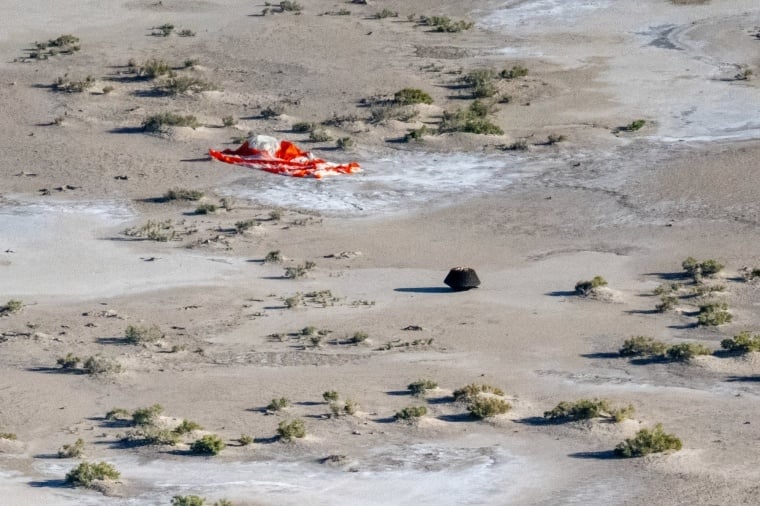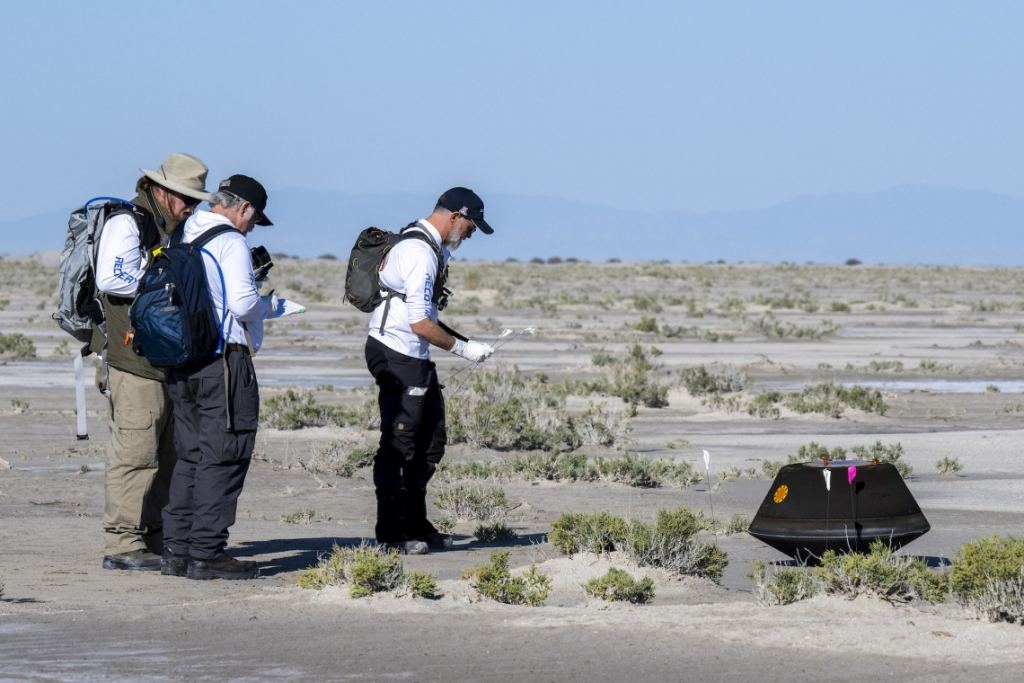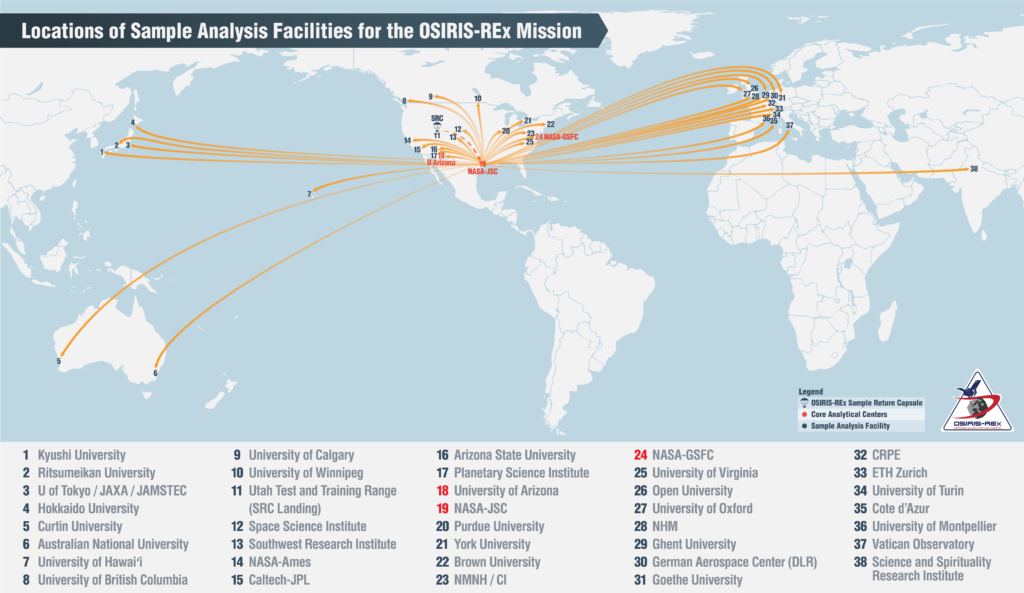Most of the spacecraft we send out into the Solar System are never meant to return. Time, space, and entropy overtake them, or else they're purposely sent crashing to their doom at the end of their missions. But not OSIRIS-REx. Its mission was only a success when it returned to Earth with its rare cargo.
NASA's OSIRIS-REx collected its sample of asteroid Bennu in October 2020. Since that time, we've been eagerly awaiting the material's delivery to Earth, where it can be scrutinized rigorously in laboratories in different nations.
On September 24th, after a two-year journey from Bennu to Earth, the long-anticipated day arrived, and the spacecraft released its sample-return capsule. NASA used the spacecraft's cameras to record the release.
The Sun is at the top of the image, and at the left of the image, a crescent Earth is visible. The image is processed to remove scattered sunlight and prevent the Earth from saturating the image. As a result, we can see the capsule and the rare cargo it holds as it heads down to Earth.
The capsule was released from Bennu at 4:42 AM at a distance of over 100,000 km (63,000 miles) from Earth. When it entered the atmosphere, the sample capsule was screaming along at 44,500 km/h (27,650 mph.) The capsule is designed to withstand all the heat from the friction, but not an impact. The capsule deployed its drogue parachute at 8:44 AM, and by the time it landed, its speed was reduced to 18 km/h (11 mph.)
This animation shows how the maneuver played out.
The whole operation wasn't without drama, though.
The sample return capsule uses two parachutes. At first, the capsule was travelling so fast that deploying a standard type of parachute would be ineffective. It would simply be torn to shreds or ripped away from the spacecraft.
To avoid this, the capsule first deploys a drogue chute. Drogue chutes are designed to be deployed from high-speed objects because they're smaller. They lower an object's velocity but not enough to land. The sample return's drogue chute scratched enough of the capsule's speed that it was safe to deploy its landing chute without it being torn apart. But the mission team didn't receive confirmation that the drogue chute had deployed. And without it, it would've been game over.
Dante Lauretta is OSIRIS-REx's principal investigator. In a press briefing after the capsule landed, he explained the intense anxiety leading up to the capsule's safe landing as he rode in a helicopter toward the landing site. "I was just trying to make sure I didn't totally break down in front of an international audience, right? It's like, okay, you got to keep it together," Lauretta said.
When they finally heard that the main chute deployed properly, the floodgates opened. "I knew the moment the chute opened that was it. We knew what to do," Lauretta continued. "There were no surprises left. And it was overwhelming relief, gratitude, pride, awe, and really trying to convince myself that I wasn't dreaming; that it was actually happening; that the chute was open; that the capsule was coming down; and we got that science treasure in hand."
The entire process, down to the landing, was flawless.
"Boy, did we stick that landing," Lauretta said, "and that is pretty much what OSIRIS-REx has done consistently."
Now comes the science.
Asteroid Bennu is a carbonaceous asteroid, the most common type. About 75% of asteroids are C-types like Bennu. They're relics from the Solar System's earliest days, and they hold clues to how the Solar System, including the Earth, formed. Bennu was chosen from a list of over 500,000 candidate asteroids. C-type asteroids typically contain lots of volatile ices, and scientists hope the sample from Bennu will have volatiles, organic compounds, and even pristine carbon from the primitive Solar System.
The samples are making their way to two places. One is NASA's Astromaterials Research and Exploration Science Directorate at the Johnson Space Center. But Japan has their own expertise in [handling returned samples](https://en.wikipedia.org/wiki/Hayabusa2#:~:text=Hayabusa2%20(Japanese%3A%20%E3%81%AF%E3%82%84%E3%81%B6%E3%81%952%2C,first%20time%20in%20June%202010.), and some of OSIRIS-REx's treasure will head to Japan's Extraterrestrial Sample Curation Center. From there it'll be distributed to different researchers.
Jason Dworkin is an astrobiologist and an OSIRIS-REx project scientist at NASA's Goddard Space Flight Center. "When the sample returns, 233 scientists globally, including me, will get to explore the asteroid in our labs," Dworkin said prior to the mission's successful completion. "In doing so, we will address dozens of questions about asteroids, the early solar system, and the origins of life."
Three quarters of the sample will be stored at NASA's Johnson Spaceflight Center for future use. This is how the Apollo samples have been curated, and it's proven effective. As scientific methods and analytical tools advance, they can be applied to pristine samples.
There are four broad questions that Dworkin and other scientists are keen to find answers to:
- Does the sample contain organic compounds that could have influenced the origins of life?
- How does the Bennu sample compare with our interpretation of data collected at the asteroid?
- What does the sample tell us about the history of the solar system?
- How has the sample changed since the spacecraft collected it?
Years of study will generate answers to these questions.
But for now, the team behind OSIRIS-REx is enjoying the warm glow of a successful mission.
"The whole team had butterflies today, but that's the focused anticipation of a critical event by a well-prepared team," said Rich Burns, project manager for OSIRIS-REx at NASA's Goddard Space Flight Center. "For us, this was the World Series, ninth inning, bases-loaded moment, and this team knocked it out of the park," he said after the capsule landed successfully.
With the Bennu sample safely in the hands of scientists, OSIRIS-REx's mission is over. But the spacecraft is still going. It's being sent to the near-Earth asteroid Apophis, and has been renamed OSIRIS-APEX (Apophis Explorer.) It'll rendezvous with Apophis in April 2029 and will orbit the asteroid for about 18 months, gathering observations.
It won't take any samples, though it will use its sampling arm to disturb the asteroid's surface and take a look at what's underneath.
 Universe Today
Universe Today



